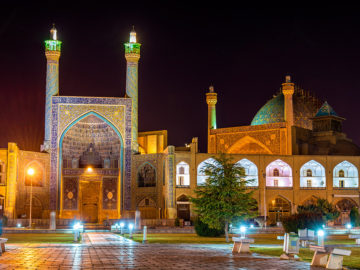
Vank is a splendid monastery in Isfahan with a gilded ceiling and exquisite paintings. its origin dates back to the early 17th century when in the south of Zayande-rood river a neighborhood was established for the Armenians who were forced to immigrate to Iran, a large group of them lived in one of Isfahan’s neighborhood and called it Jolfa.

After the large immigration, Armenians decided to build their social facilities and religious buildings used for both religious and cultural functions. From 1604 to 1606, a small church was built that later was destroyed, because it could not inhabit the increasing population of Armenian in Iran. Then a splendid church was built under the supervision of Archbishop David that took nine years to finish.
Vank cathedral follows the architecture of Saint Stephanos Monastery in Jolfa. The church is built on a land with an area of 8732 m2, and unlike the Armenian churches that were made of stone, it was made of raw clay; its exterior walls were formed with bricks and the interior walls were designed with plaster. The interior of the church follows the Armenian architecture; however, the exterior has an Iranian architecture style. The church has two domes, the small one stands on public seats and the huge dome is situated in the front of the church’s sanctuary, and like many Iranian domes, it is double cased. The Vank cathedral consists of a clock tower, a printing place, a library, a museum, a prayer hall, a bell tower and an administration place.

Clock tower is a three story building and stands upon the entrance of the church. A big, 300 kg clock dominates its second floor. The first printing office of Iran and the Middle East is located here. It was built in 1640 under the administration of Khachatur Kesaratsi from the Armenian diocese of Isfahan. The press that was brought by an Armenian from Europe in 1844 has been kept in the church museum as well. The treasury of the library dates back to the Armenians’ great migration when they left everything behind except their books that were brought to Iran. From 1770 to 1790, because of the social conditions, many of the books were sold. After some years, and with much effort, all the books were re-collected. In 1884, part of the church was dedicated to make a library, which is situated in the west side of church.

After the museum’s entrance and after passing the corridor, in the right side of the ramp, a bell tower is seen. In the right side of this tower, an inscription in blue surrounded by crusader stones exist that were took from the destroyed church of Jolfa of Isfahan. In addition, a memorial monument in the left side of bell tower commemorate the Armenians genocide in 1915 by the Ottomans. Furthermore, every year on April 23rd a ceremony is held to honor the Armenians martyrs. The two tombs under the bell tower are dedicated to an Armenian solider and an Armenian head of army.

The edifice of museum was constructed in 1871. It is a place to hold the luxurious goods that were donated by the Armenians to be held and be a reminder of who their ancestors were. Today there are large numbers of Bibles kept in the museum that one of them is the smallest bible in the world that was written in seven languages and weights only seven grams. It also includes exquisite collection which has commands issued by the Safavid kings and governors about the Armenians. This is a very important and significant collection for the study of Armenian history in Iran. Other objects held in this museum consist of the paintings of the European painters that were donated to the church, some valuable manuscripts, the oldest book that was established in Isfahan and the first press.
The prayer hall is like a parallelogram that is divided in two quadrilateral parts, the first part is prayer hall and the second part is the dome chamber. All the interior surface of the dome and alter are painted with Biblical scenes of Adam and Eve creation story. The exterior part of the dome is without decoration with simple bricks.
 The administration place is located in the southern part of the monastery and goes back to the region of Nasser Adin Shah. Registering the death, birth, and marriage of the Armenians, certificates like complaints and judicial proceedings were conducted here.
The administration place is located in the southern part of the monastery and goes back to the region of Nasser Adin Shah. Registering the death, birth, and marriage of the Armenians, certificates like complaints and judicial proceedings were conducted here.

The Archbishop residence is a two story building that is located in the east part of the monastery and in front of the museum. There are also some tombs in the churchyard that are dedicated to the political representatives of the European countries that passed away in Isfahan. Today Vank cathedral is a mother church of Armenians.

